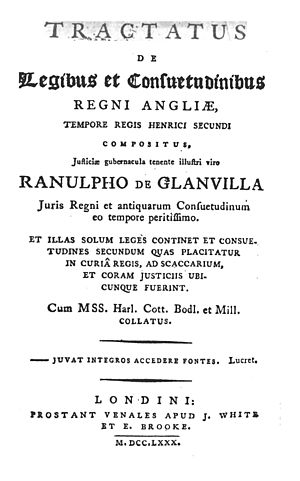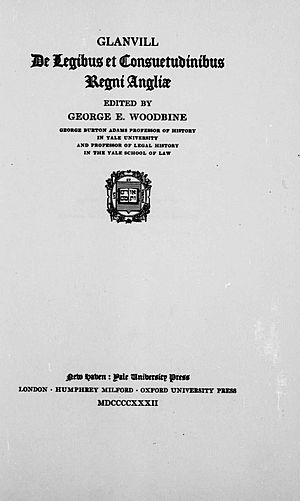Tractatus de legibus et consuetudinibus regni Anglie facts for kids
The Tractatus de legibus et consuetudinibus regni Angliae (which means Treatise on the Laws and Customs of the Kingdom of England), often called the Glanvill treatise, is the very first book about English law. It was written a long time ago, between 1187 and 1189. People believe it was written by Ranulf de Glanvill, who was an important judge and advisor to the King.
This book was very important because it was the first to organize and write down English laws in a clear way. It explained how legal cases should work and introduced new ideas like writs (special orders from the King's court). Many of these ideas are still used in law today! The Glanvill treatise is seen as a foundational text for English common law, which is a system of law based on past court decisions.
The Tractatus was created for King Henry II, who ruled from 1154 to 1189. The King wanted to bring peace and order back to England after a time of trouble. This book helped him do that by making the laws clearer and fairer. Later, another important law book called De legibus et consuetudinibus Angliae by Henry de Bracton (who lived around 1210–1268) became the main source of English law, but it was greatly influenced by the Tractatus.
There's been some discussion about who exactly wrote every part of the Tractatus. Some ideas in the book came from Glanvill's nephew, Hubert Walter. However, it's generally agreed that Glanvill oversaw the project and approved it. So, people usually say it's "commonly attributed to Glanvill" to show he was the main person behind it.
Understanding the Tractatus
In the past, before printing presses were common, writers often copied ideas and parts from older books without saying exactly where they got them. The introduction of the Tractatus is a good example. It's very similar to the introduction of an older Roman law book called the Institutes of Justinian. Both introductions talk about how good laws and government help create justice, which is what the King wants.
The Tractatus is made up of fourteen different sections, or "books." It mainly focuses on the types of cases handled by the Curia Regis, which was the King's own court.
The Fourteen Books Explained
The Tractatus is divided into fourteen books, each covering different aspects of law and court procedures. Here's a simple look at what each group of books covers:
Books 1-3: Starting a Case
| No. | Chapters | What it's about |
|---|---|---|
|
|
|
Cases handled by the King's Court or the Sheriff; how to delay a court date (called Essoins); and the first steps before people go to court. |
|
|
|
How people are called to court, how they appear, what they say in court, how trials happen (like trial by combat or the Grand Assize), and how decisions are made. |
|
|
|
Rules about proving who owns land, especially when two different lords are involved. |
These first three books explain how a "Writ of Right" works. This was a special order used to claim land, and these books describe all the steps involved when a case started in the King's Court.
Books 4-11: Different Legal Topics
| No. | Chapters | What it's about |
|---|---|---|
|
|
|
Rights related to church property and who can appoint priests (called Advowsons). |
|
|
|
Rules about people's social status, including villeins (people tied to the land). |
|
|
|
Rules about Dower (a wife's share of her husband's property after he dies). |
|
|
|
How property is sold or given away, how it passes down through families, and rules about wills. |
|
|
|
Rules about official agreements and court records. |
|
|
|
Rules about loyalty to a lord (Homage, Fealty), payments to a lord (Relief), services owed, and problems with property boundaries. |
|
|
|
Rules about debts from different types of agreements, pledges, and written promises. |
|
|
|
Rules about attorneys (people who represent others in court). |
These books cover many different legal situations that would start in the King's Court.
Books 12-14: Other Court Actions
| No. | Chapters | What it's about |
|---|---|---|
|
|
|
How cases that start in a local lord's court can be moved to the County Court or the King's Court. It also mentions other types of orders handled by the Sheriff. |
|
|
|
Explains trials by Assizes (early forms of jury trials) and different ways people could be wrongly removed from their land. |
|
|
|
Rules about serious crimes that were handled by the King's authority. |
Different Editions of the Book
Over the centuries, many copies and versions of the Tractatus have been made and printed. Here are some important ones:
| Year | What happened |
|---|---|
|
|
A new version was written or copied by Robert Carpenter of Haresdale. |
|
|
The book was first printed by R. Tottle. |
|
|
Printed by Thomas Wight; the text was checked and corrected using different old handwritten copies. |
|
|
An exact copy of Wight's 1604 edition was printed, but it left out the introduction. |
|
|
Printed in a large collection of Anglo-Norman customs by Houard in Rouen, France. |
|
|
Published by John Rayner. This version was carefully compared with several important old manuscripts, including those from the Bodleian Library and the Cottonian Collection. |
|
|
The first English translation from Latin was published by John Beames. |
|
|
Printed as an extra part of George Phillip's book on English history and law. |
How the Tractatus Changed Things
Immediate Effects
The ideas in the Tractatus and the use of writs (King's orders) changed how courts worked. They made the King's Court more powerful than other local courts. The King also sent judges on "circuits" around the country, bringing the King's justice to everyone. This made legal cases faster because delays were not easily allowed.
The King's Court became the main place to settle disagreements about land. Instead of old methods like trial by ordeal or trial by combat, the book promoted a more logical way to find the truth: by weighing evidence in a court hearing, which later led to the idea of a jury.
At this time, the idea of "res judicata" also became important. This means that once a court makes a decision, it's final. This helped make the King's reforms stronger, showing that the Tractatus was part of a bigger plan to improve justice.
Church courts still handled things like marriage, wills, and church matters. But the King's writs stopped them from getting involved in other areas of law.
All these changes helped unite England under one system of law. Trial by jury in the King's Court became very popular. This helped create a strong respect for the law in English culture, making people more willing to accept court decisions.
Its Importance in Legal History
The writs and court procedures described in the Tractatus were the beginning of English common law. They also laid the groundwork for English land law, which deals with property disputes. The idea of using a jury to weigh evidence and find the truth eventually replaced all other methods and became the standard way to decide facts in a trial.
Ranulf de Glanvill is often mentioned in books about English law, whether they are histories or books about specific legal topics. He is recognized as one of the earliest and most important authorities on English law. You might see his name spelled in different ways, like Glanvil, Glanvill (which is most common), or Glanville.
Influence on Scottish Law
The Tractatus even influenced the law in Scotland. A Scottish law book called the Regiam Majestatem was written around the early 1300s. About two-thirds of this Scottish book was taken directly from the Tractatus. Other parts were very similar, and the rest of the Regiam Majestatem covered crimes, which was different from Glanvill's book.
See also
- English land law
- English contract law
- English law



